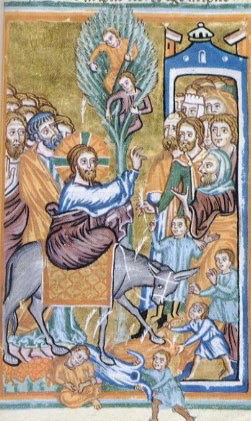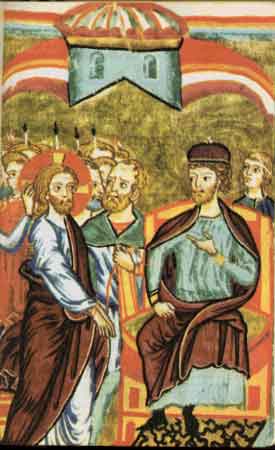The Schema
of Septuagesima & Lent
X
The progression of Lent can be understood as follows:
Pre-Lent:
Septuagesima Sunday. Exile and the need for asceticism. (Depositio of the Alleluia
the night before.)
Sexagesima Sunday. The perils of exile (persecution) and the fruits of asceticism
(the Word being sown into our hearts).
Thursday after Sexagesima: Carnival
Quinquagesima Sunday (a.k.a. Carnival, or Shrove Sunday). "We are going up to
Jerusalem" -- a setting of the stage for the pilgrimage of Lent, and the one thing we
must bring with us: charity. [Also, traditional time for going to confession]
Shrove Monday. [Traditional time for going to confession]
Shrove Tuesday. [Traditional time for going to confession]
|
| Lent:
Ash Wednesday. The solemn season begins with a reminder of our mortality and our
profound need for repentance and conversion.
First Sunday of Lent. The model for our fasting, Christ in the desert, and the kinds
of temptations we can expect to encounter.
Lenten Embertide (Wednesday, Friday, and Saturday). See Ember
Days, etc.
Second Sunday of Lent. As Paul exhorts us to keep up our progress, we hear the story
of the Transfiguration as a heartening foretaste of Christ's ultimate triumph.
Third Sunday of Lent. Christ again foreshadows His victory (this time over the
devil), but as we move closer to Passiontide, He also hints at the way in which this will
be done.
Mid-Lent:
Wednesday before Laetare Sunday: beginning of Mid-Lent.
Fourth Sunday of Lent (a.k.a. Laetare, or Mid-Lent Sunday). A note of joy is
struck, for having died to sin with Christ during Lent, we will rise again with Him and be
part of His mystical Body, the Church which is the new Jerusalem. Thus the Introit:
"Rejoice, Jerusalem."
Wednesday after Laetare Sunday: end of Mid-Lent.
|
| Passiontide:
(First) Passion Sunday. The Jews' growing hatred of Christ recorded in today's
Gospel makes plain His imminent death.
Friday after Passion Sunday: Feast of the Seven Sorrows of the Blessed Virgin Mary.
A special commemoration, one week before Good Friday, of Mary's com-passion for
(literally, "suffering with") Her innocent son.
(Second Passion or) Palm Sunday. Christ's triumphant entrance into Jerusalem and the
account of His Passion according to St. Matthew.
Holy Week: |

Christ's Triumphant Entry in Jerusalem |
- Monday of Holy Week.
The Gospel for the Mass gives an account of Judas' character,
foreshadowing his act of betrayal.
- Tuesday of Holy Week.
The account of Christ's Passion according to St. Mark.
- Spy Wednesday.
The account of Christ's Passion according to St. Luke during the
daily Mass; and the nocturnal office of Tenebrae, a sustained reflection on the
treachery of Judas, the privation of holiness, and the need for conversion.
- Maundy Thursday.
A celebration of the institution of the Eucharist and the
priesthood.
|

Jesus before the
High Priest |
- Good Friday.
A mournful commemoration of the death of our Lord.
- Holy Saturday.
During the morning and afternoon, a mournful remembrance of our Lord
in the tomb.
|

The Meaning of Septuagesima & Lent
Customs |
Foods
Liturgical Year Page | Latin Mass Homepage |